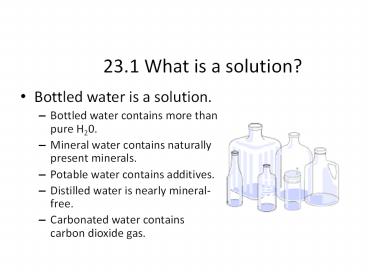23.1 What is a solution? - PowerPoint PPT Presentation
1 / 16
Title:
23.1 What is a solution?
Description:
Different Solutions 23.1 Colloids and Suspensions Colloids and ... 23.2 Dissolving Rate Microencapsulation is used by pharmaceutical companies in time ... – PowerPoint PPT presentation
Number of Views:39
Avg rating:3.0/5.0
Title: 23.1 What is a solution?
1
23.1 What is a solution?
- Bottled water is a solution.
- Bottled water contains more than pure H20.
- Mineral water contains naturally present
minerals. - Potable water contains additives.
- Distilled water is nearly mineral-free.
- Carbonated water contains carbon dioxide gas.
2
23.1 Solutions
- A solution is a mixture of two or more substances
that is homogeneous at the molecular level. - The particles in a solution exist as individual
atoms, ions, or molecules.
- A solution is a mixture of solute dissolved in a
solvent. - (An alloy is a solution of two or more metals.)
3
Different Solutions
4
23.1 Colloids and Suspensions
- Colloids and suspensions are NOT solutions.
5
23.1 Colloids and Suspensions
- Colloid particles are formed from clusters of
atoms or molecules. - Suspensions are mixtures that settle upon
standing. - Filtering a suspension will separate the
different components.
6
(No Transcript)
7
23.1 What is a solution?
- Key Question
- Can you identify mixtures as solutions,
suspensions, or colloids?
Read text section 23.1 BEFORE Investigation 23.1
8
23.2 Dissolving Rate
- Stream or lake water may contains microscopic
parasites. - Adding iodine tablets can kill microbes such as
bacteria or viruses. - How can we increase the dissolving rate of the
tablet?
9
23.2 Dissolving Rate
- Stirring a mixture speeds dissolving.
- Stirring exposes fresh solvent to newly exposed
solute. - Crushing a solute table increases the surface
area exposed to the solvent - Every time a piece is divided the surface area
increases.
10
23.2 Dissolving Rate
- Microencapsulation is used by pharmaceutical
companies in time-release medicines. - The medicines are coated with a polymer, usually
from gelatin, silicone or cellulose. - Varying the thickness of the coating changes the
dissolving rate.
11
23.2 Dissolving Rate
- Key Question
- How can you influence dissolving rates?
Read text section 23.2 BEFORE Investigation 23.2
12
23.3 Solubility
- A system is a collection of matter and processes
that take place in a certain space and can be
observed and studied. - Systems can be open or closed.
- A solute and solvent make up a system.
13
(No Transcript)
14
23.3 Solubility
- The term solubility means the amount of solute
that can be dissolved in a specific volume of
solvent under certain conditions. - Several factors affect solubility
- chemical nature of the solvent
- the volume of solute
- temperature
15
(No Transcript)
16
23.3 Solubility of Gases
- The solubility of gases in liquids decreases as
temperature increases. - The solubility of a gas also depends on pressure.































